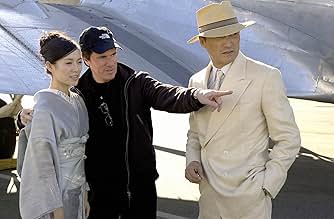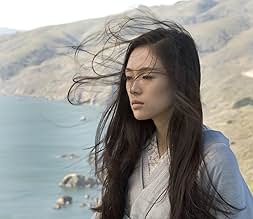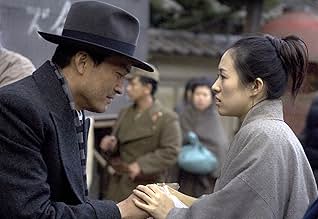Nitta Sayuri révèle comment elle a transcendé ses origines dans un village de pêche pour devenir l'une des geishas les plus célèbres du Japon.Nitta Sayuri révèle comment elle a transcendé ses origines dans un village de pêche pour devenir l'une des geishas les plus célèbres du Japon.Nitta Sayuri révèle comment elle a transcendé ses origines dans un village de pêche pour devenir l'une des geishas les plus célèbres du Japon.
- Réalisation
- Scénario
- Casting principal
- Récompensé par 3 Oscars
- 32 victoires et 47 nominations au total
Avis à la une
In Japan of the 20's, the nine years old Chyio (Suzuka Ohgo) and her sister Satsu (Samantha Futerman) are sold by her fisherman father to a Geisha house in Miyako. Satsu is not accepted in the house and is sent to a brothel, and along the years, Satsu escapes from he brothel where she lived and the rebel Chyio is left alone, becoming a slave of a geisha. However, six years later, she learns how to become the geisha Sayuri (Ziyi Zhang) with the support of the successful Mameha (Michelle Yeoh), while fighting against the evil and jealousy of the wicked Hatsumomo (Gong Li). While still a child, Chyio falls in love with The Chairman (Ken Watanabe), and in the post-WWII, they meet each other, in a period o changes in Japan with the occupying American forces and the country completely destroyed.
The first half of "Memoirs of a Geisha" is a beautiful drama, telling the story of the country girl Chyio alone and adapting to a new life style in a house of geisha. Then, in the end of World War II, the screenplay becomes a soap-opera and the story becomes lesser and lesser attractive. However, the cinematography, the art direction and the costume design are amazing along the whole movie. But the cast speaking in English and keeping some Japanese words seems quite ridiculous for me. For such a careful production, this seems to be an unforgivable mistake. My vote is eight.
Title (Brazil): "Memórias de uma Gueixa" ("Memoirs of a Geisha")
The first half of "Memoirs of a Geisha" is a beautiful drama, telling the story of the country girl Chyio alone and adapting to a new life style in a house of geisha. Then, in the end of World War II, the screenplay becomes a soap-opera and the story becomes lesser and lesser attractive. However, the cinematography, the art direction and the costume design are amazing along the whole movie. But the cast speaking in English and keeping some Japanese words seems quite ridiculous for me. For such a careful production, this seems to be an unforgivable mistake. My vote is eight.
Title (Brazil): "Memórias de uma Gueixa" ("Memoirs of a Geisha")
As someone thet has treasured the book, I will be honest. At first I didn't want to watch it. This could have gone wrong in so many ways. But the movie has blown me away.
Many laugh's, moments of deep emotion and true heart must have been put in this movie. And the moments of joy, fun and above all pain and even some tearing happened to me.
It is absolutely beautiful. 10/10 in my life I have ranked over 1130 films and have given a 10 to less then twenty movies, but this must be amongst to top 5 best ones.
I mean wow, the film is so beautiful.
Many laugh's, moments of deep emotion and true heart must have been put in this movie. And the moments of joy, fun and above all pain and even some tearing happened to me.
It is absolutely beautiful. 10/10 in my life I have ranked over 1130 films and have given a 10 to less then twenty movies, but this must be amongst to top 5 best ones.
I mean wow, the film is so beautiful.
I lived in Japan for 3 years and I loved the book, rich with visual imagery. I went to the see the movie with a good deal of trepidation, convinced that they were going to butcher it and sex it up to appeal to American audiences. Instead I sat spellbound in my seat as I watched the images that Arthur Golden has created in my mind with words years before, play themselves out on the screen in front of me. Every shot, ever scene, every tiny detail was just beautiful. I literally did not look away from the screen the entire time. The acting wasn't spectacular. I think they could have found somebody better to play Sayuri. The children were all wonderful. The stand-out actress by far was Gong Li as Hatsumomo. The villain had the best opportunities to show her skills as a thespian. The plot stuck very closely to the book. They eliminated the scenes that they needed to in the interest of time, but they didn't try to take any shortcuts or speed up the plot. I really felt like the story was played out beginning to end without sacrificing any of the meat. You'll read a lot of reviews in the coming weeks praising the gorgeous photography. Every word is true. Words like "lush" and "exquisite" only begin to do it justice. I've never had the experience of being transported to another time by a movie in quite this way.
Going into the film, I had worries with all the slamming critics have given, even though I didn't read all of them in details. However, I'm happy to say it turns out to be one of more satisfying movie experiences of the year.
First I echo the sentiment that the film is simply technically perfect. The retro-mood it created had me immensed in the world of geisha from beginning to the end. It's very 1930 Shanghai like. The music score isn't as haunting as the one in CTHD, but it is still masterfully composed and fits in the background very well. It's worth seeing for the big screen experience alone. The story also never dragged, as each of the three parts flowed nicely. I normally don't like voice-over, but here it really held the movie together and helped to move the story along.
As for the accents, the problem has definitely been exaggerated. I was expecting a lot of unpleasant broken English to be spoken, but they all sounded fine to good, not just from the most fluent Michelle Yeoh, but Ken Watanabe, Youki Kudoh (who plays Pumpkin) and other supporting casts. Gong Li had a few awkward lines at the beginning, and Ziyi had more and is the one who had to try the hardest, but both pulled off admirably and didn't hurt their performances in the process.
Talking about performances, I think almost all of them did well. It's much more of an ensemble piece, and I was especially impressed by the young Sayuri and Ken Watanabe.
The main problem I have is with character development. It is a Cinderella story at heart, but the good and evil are too clear-cut and lack dimension. I also want to see more ups and downs for the competition between Ziyi and Gong Li. Gong did all she could, but the script didn't allow her to be a worthy opponent. Except for some verbal back-and-forth between the two and a few dirty tricks from Gong, there was no reason to believe why she was the most famous geisha in Japan before Ziyi arrived.
In addition, the Mother character is over-the-top and didn't fit the emotional aspect the film quite well, although she did provide some comical moments. The big dance scene had excellent buildup, but the execution of the dance felt flat. It lasted only about 30 seconds, while doubling that and making it more mesmerizing would have made the whole middle act more effective.
These flaws didn't overshadow the fact that what was put on screen worked for me. Will I be willing to watch it again with friends? In a heartbeat. Will I recommend it to others? Definitely. With that in mind, I give the film an A-.
First I echo the sentiment that the film is simply technically perfect. The retro-mood it created had me immensed in the world of geisha from beginning to the end. It's very 1930 Shanghai like. The music score isn't as haunting as the one in CTHD, but it is still masterfully composed and fits in the background very well. It's worth seeing for the big screen experience alone. The story also never dragged, as each of the three parts flowed nicely. I normally don't like voice-over, but here it really held the movie together and helped to move the story along.
As for the accents, the problem has definitely been exaggerated. I was expecting a lot of unpleasant broken English to be spoken, but they all sounded fine to good, not just from the most fluent Michelle Yeoh, but Ken Watanabe, Youki Kudoh (who plays Pumpkin) and other supporting casts. Gong Li had a few awkward lines at the beginning, and Ziyi had more and is the one who had to try the hardest, but both pulled off admirably and didn't hurt their performances in the process.
Talking about performances, I think almost all of them did well. It's much more of an ensemble piece, and I was especially impressed by the young Sayuri and Ken Watanabe.
The main problem I have is with character development. It is a Cinderella story at heart, but the good and evil are too clear-cut and lack dimension. I also want to see more ups and downs for the competition between Ziyi and Gong Li. Gong did all she could, but the script didn't allow her to be a worthy opponent. Except for some verbal back-and-forth between the two and a few dirty tricks from Gong, there was no reason to believe why she was the most famous geisha in Japan before Ziyi arrived.
In addition, the Mother character is over-the-top and didn't fit the emotional aspect the film quite well, although she did provide some comical moments. The big dance scene had excellent buildup, but the execution of the dance felt flat. It lasted only about 30 seconds, while doubling that and making it more mesmerizing would have made the whole middle act more effective.
These flaws didn't overshadow the fact that what was put on screen worked for me. Will I be willing to watch it again with friends? In a heartbeat. Will I recommend it to others? Definitely. With that in mind, I give the film an A-.
As someone who read the book before watching the movie, I was pleased with the adaptation. The right parts were highlighted and felt the cuts made were necessary for length. The story is truly a tragically beautiful one, and the actors cast fit their characters. Great acting and some beautiful cinematography. Sayuri's dance scene was mesmerizing.
Le saviez-vous
- AnecdotesThe elements of nature are a running theme through this film and each of the four main Geisha have an elemental character. Sayuri is water, Mameha is wind, Pumpkin is wood (the equivalent of earth) and Hatsumomo is fire.
- GaffesWhen Hatsumomo and Pumpkin are leaving on the night of Pumpkin's debut, neither Mother nor Auntie spark flint on their backs. A Geisha would never leave her okiya without this act being performed as it was believed it brought good luck.
- Crédits fousNo studio logos are shown at the beginning; they appear shortened after the end credits and are accompanied by the film's score.
- ConnexionsFeatured in The 63rd Annual Golden Globe Awards 2006 (2006)
- Bandes originalesAnata No Mono Yo
Written by Takao Saeki and Kôka Sassa
Performed by Noriko Awaya
Courtesy of Columbia Music Entertainment, Inc.
Meilleurs choix
Connectez-vous pour évaluer et suivre la liste de favoris afin de recevoir des recommandations personnalisées
Détails
- Date de sortie
- Pays d’origine
- Site officiel
- Langues
- Aussi connu sous le nom de
- Memorias de una geisha
- Lieux de tournage
- California State Railroad Museum - 111 I Street, Sacramento, Californie, États-Unis(interiors: railroad station)
- Sociétés de production
- Voir plus de crédits d'entreprise sur IMDbPro
Box-office
- Budget
- 85 000 000 $US (estimé)
- Montant brut aux États-Unis et au Canada
- 57 490 508 $US
- Week-end de sortie aux États-Unis et au Canada
- 682 504 $US
- 11 déc. 2005
- Montant brut mondial
- 162 242 962 $US
- Durée2 heures 25 minutes
- Couleur
- Mixage
- Rapport de forme
- 2.39 : 1
Contribuer à cette page
Suggérer une modification ou ajouter du contenu manquant








































